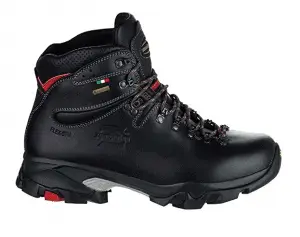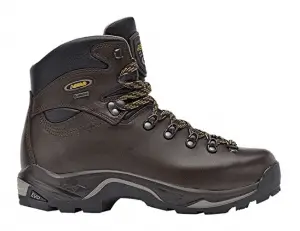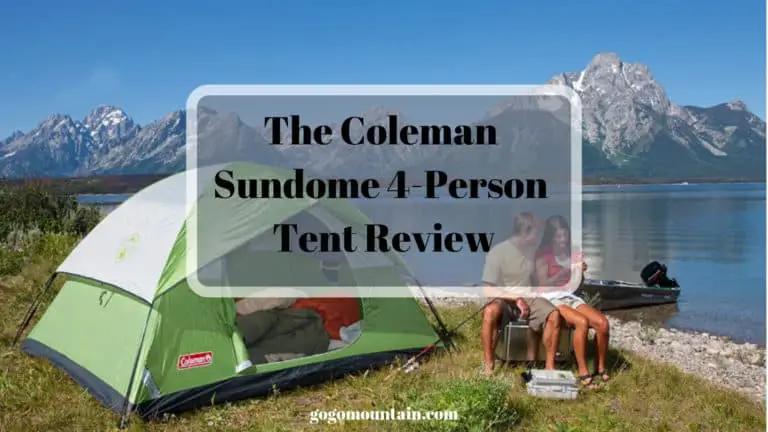Best Men’s Boots for Backpacking in 2022
You know that it’s critical to use good boots when you go backpacking. Boots have different features as far as traction, weight, ankle support and breathability goes.
In this review, I’ll show you what to look for in choosing your backpacking boots. As well, review 5 of the best Men’s backpacking boots in 2021 from my experience.
That will help you choose your backpacking boots based on the expected conditions during your trip.
With so many to choose from it was hard to narrow down to only 5. I have picked some of the best on the market. I have reviewed personal experience with the price, quality, comfort, safety and durability. So if you’re trying to find the best backpacking boots for you, you’ll find these tips and review helpful.
[toc]
5 Best Men’s Backpacking Boots
In this section, I selected the top 5 best Men’s backpacking boots. These boots are specifically designed for long hikes while wearing a heavy backpack and give you good ankle support for challenging trails.
They’re also chosen because of the high level of resistance to abrasion. That makes them suitable for climbing in rocky ground. They can be used as winter hiking because they can be used with strap-on bindings (C1 crampons) or snowshoes.
If you plan to mainly trek on easy trails for day hikes, hiking shoes or trail running shoes are likely more suitable for your purpose.
All the boots here are good for:
- Hiking with a heavy backpack
- Mountaineering
- Via Ferrata
- Backpacking
- Hiking with Snowshoes
- Hiking with Crampons (C1)
1. Zamberlan Vioz GT
These boots are perfect for climbing in rocky landscapes and backpacking, and very comfortable. In addition, the boots have durable, rugged uppers from full grain leathers for excellent resistance to abrasion and the Gore-Tex linings will protect your feet against moisture in wet weather.
Also, the polyurethane midsoles provide great comfort while you carry a hefty backpack while taking a hike on a rocky trail that is technically challenging.
The midsoles also feature stabilizers in the back for improved support and stability. The boots have 3D soles from Vibram which feature thick, widely spaced lugs that offer outstanding downhill braking, traction, and makes is easy to remove dirt.
Zamberlan’s Flex System allows flex forward although these boots can be moderately stiff. In conclusion, these boots are great for people who need boots that are extremely durable for long mountaineering and backpacking trips on rough terrain.
2. Asolo TPS 520 GV
These backpacking boots provide great durability due to their robustness. They are however also the heaviest of those reviewed here. The boots come with uppers made from full-grain, water-resistant leather 2.7 millimeters thick. Therefore, this makes them perfect for hiking in rocky terrain where resistance to abrasion is very important. Due to the leather being relatively rigid, great ankle support is provided.
The Asolo TPS 520 GV boot has Gore-Tex linings that increases weather protection, as well as high-quality TPS soles.The soles contain three cylinders to provide better stability and shock absorption. These boots are perfect to use in rocky terrain, whether for mountaineering or long backpacking trips.
3. Lowa Renegade
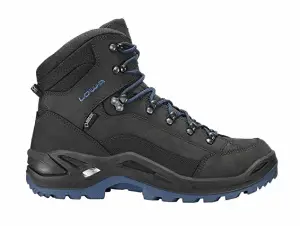
These backpacking boots are lighter than for example the boots from Zamberlan discussed previously but their uppers are not as durable. Due to their low weight, the boots from Lowa Renegade are also comfortable and efficient on easy trails. The uppers are made from nubuck leather that is very breathable. The Gore-Tex linings below the uppers will keep those feet drier in the wet.
The boots also feature midsoles manufactured from double density polyurethane and Climate Control branded insoles. Outsoles by Vibram Evo provide excellent traction, while their unique lug patterns provide excellent performance various types of terrain. Therefore, these boots are the best choice for individuals who need high-quality, versatile boots for various types of outdoor adventure.
4. Salomon Quest 4D 3 GTX
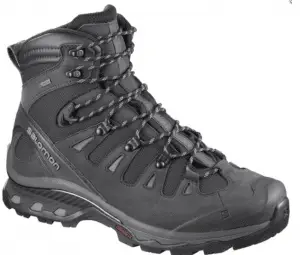
These boots is relatively lightweight and are very comfortable to wear. The uppers are made from a combination of synthetic materials and leather. It provide excellent breathability.
The Quest boots are also provided with Contagrip outsoles, EVA midsoles and Gore-Tex linings. The Contagrip outsoles are made from elements with various densities.
As the toe and heel areas are prone to high wear and tear, these are made from high-density materials, while low-density materials are used for areas that are less exposed. In addition, this type of construction design allows for the reduction of the overall boot weight without compromising the durability. These boots also feature a 4D chassis that provides better stability and support.
5. Salewa Mountain Trainer Mid
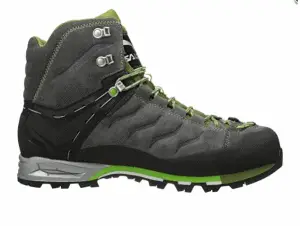
These boots have been designed specifically for via ferrata and technical hiking. They could also be efficiently and comfortably worn on extended backpacking hikes where solid ankle support is a must. These boots have uppers manufactured from nubuck leather, thus providing excellent breathability. The boots are protected against abrasion with a rubber rand all around it.
In addition, for increased ankle support, they come equipped with the 3F System rubber inserts in the area around the ankles.
These boots also have Alpine Approach branded outsoles by Vibram and Gore-Tex linings.
Also, these boots by Salewa are not as heavy as the Asolo or Zamberlan boots reviewed above. They are slightly less resistant to abrasion and less durable. They are however a good option for shorter mountaineering and backpacking trips.
6 Things to Look for When Buying Backpacking Boots
1. Uppers
The uppers of backpacking boots are often made from leather or sometimes a mixture of synthetic materials and leather to provide durability and abrasion resistance. Different types of leather is available, including nubuck, split-grain and full-grain.
Apart from providing good breathability, it is flexible and light.
Split grain leathers is when a hide has the top part of the grain detached, making it not as thick as what full grain leathers is.
Although this means it provides lower resistance to abrasion, it does make it lighter and very flexible and breathable than what full-grain leather is.
Full-grain leather is water-resistant, rigid and the most durable.
2. Weight
Backpacking boots are normally heavier than what hiking boots are as they have rigid midsoles and rugged uppers that are resistant to abrasion.
Hiking boots normally have EVA midsoles that are lightweight and very flexible, and lighter synthetic uppers that are not as durable. This results in backpacking boots having better ankle support and stability than what hiking boots have.
3. Insoles
Insoles for backpacking should be breathable and moisture-wicking. They are normally imbued with anti-microbial agents to prolong freshness.
4. Midsoles
Midsoles provide support and cushioning. It is therefore a very important component of hiking boots. Midsoles are manufactured from either polyurethane (PU) or ethylene vinyl acetate (EVA).
Midsoles made from EVA are more flexible and lighter than ones made from PU. It is therefore normally used for hiking boots used on easy trails, trekking shoes and running shoes.
These are more stable to carry heavy loads and in rocky terrain. They also tend to be longer lasting than what EVA midsoles are.
5. Outsoles
Outsoles give you traction. If you need more traction on a challenging hike, it is provided with thicker and deeper lugs. While some brands like Salomon (Contagrip) design and manufacture outsoles for their own products, others prefer to incorporated outsoles provided by a specialized manufacturer like Vibram.
6. Lining
Lining is the material inside the boots. To keep feet comfortable during backpacking, linings should be moisture-wicking and breathable.
Lining is also used for insulation and winter boots therefore usually contain a good lining such as PrimaLoft for heat. Waterproof boots use breathable, waterproof linings like Gore-Tex that will keep feet dry when it’s wet.
What are the Differences Between Hiking and Backpacking Boots?
Boots made for backpacking give you better ankle support and are more robust.
They also normally have leather uppers and relatively rigid midsoles to provide good stability with walking with a heavy backpack.
Hiking boots or shoes tend to be more comfortable, more breathable and lighter.
Are Running Shoes Good For Backpacking?
There is no hard rule that says you can’t use running shoes for backpacking. However, you won’t want to use your running shoes for backpacking.
That’s because the midsoles of running shoes are not durable enough to endure the weight of a backpack and they don’t provide enough ankle support.
Synthetic uppers may also start tearing on rough terrain.
How to Break in Hiking Boots
Wear new backpacking boots for everyday errands for a number of days before going on a long trip.
It should be noted that boots probably don’t fit you properly if they are not comfortable after a few days of around town use.
Do You Need Waterproof Backpacking Boots?
This depends on the weather conditions you are expecting during your trip.
Although waterproof boots are great to keep your feet drier in wet conditions, they are not as breathable as boots that don’t have a waterproof lining.
This means that you’ll likely sweat in waterproof boots when the weather is warm.
Related posts:
Top Inspiring Hiking and Camping Quotes


